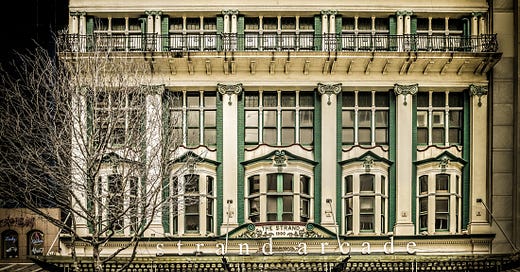NZ Visual Diary - entry 132
The Strand Arcade - Queen Street entrance
The significance of the Strand Arcade, located on Auckland’s city-centre thoroughfare Queen Street, cannot be overstated.
Heritage New Zealand, the country’s leading national historic heritage agency, has assigned the Strand Arcade to the agency’s highest category of historical places of special or outstanding value.
What follows is Heritage NewZealand’s extensive commentary1 on Auckland’s Strand Arcade.
A large ornate brick building, the Strand Arcade reflected new trends in retail development. In particular, the structure incorporated a glass-covered passageway linking Queen and Elliott Streets - a precursor to the modern shopping mall.
Commenced on 1 July 1899, construction was completed in September the following year by J. Thomas Julian (1843-1921), a major Auckland contractor. Designed by prolific Auckland architect Arthur P. Wilson (1851-1937), the building adopted an ornate Italianate style favoured for grand commercial buildings of the late-Victorian and Edwardian eras. Internally, the basement of the Elliott Street section contained offices associated with the neighbouring Albert Brewery, while the Queen Street basement housed reputedly New Zealand's largest restaurant.
The ground floor promenade accommodated nineteen specialty shops. On the floors above were warehouses, sample rooms, a meeting and gathering venue, a photographic studio and several small offices. The design mix of specialty shopping, tea rooms and meeting venues facilitating safe and respectable social interaction made the Strand Arcade a popular Auckland destination.
Aesthetic Significance or Value:
The Strand Arcade has high aesthetic significance as a visually impressive and ornate shopping arcade of late Victorian and early Edwardian date. Its well defined exterior detailing, including bay windows, pronounced attic storey with wrought iron balcony and ornate parapet make the building a notable Queen Street landmark. The place has aesthetic value for its rear façade which has segmental openings and an elaborate cartouche, features that contribute to the visual amenities of Elliott Street. The interior of the Arcade has particular aesthetic value for the impressive design of its public space which features a lofty top-lit central promenade, linking bridges, small shops and decorative plaster detailing, and for the ornamental plasterwork which survives in some of the building's retail spaces.
Architectural Significance or Value:
The Strand Arcade has high architectural significance as a rare New Zealand example of a late Victorian and early Edwardian shopping arcade, an international building type that formed a precursor to the modern shopping mall. It has considerable architectural value as one of the grandest surviving shopping arcades in New Zealand, also incorporating the remnants of what is currently believed to be the earliest surviving purpose-built arcade in the country (1899-1900).
In its rebuilt form (1909-10), it is also one of the country's earliest full-standing survivors. The Strand Arcade is also significant as a notable example of a grand shopping arcade designed in an ornate Italianate style, related to appearances adopted for the commercial buildings and residences of the urban nouveau riche in late colonial New Zealand. The building is an important commercial work by the prolific Auckland architect Arthur P. Wilson.
Social Significance or Value:
Still used for its original purpose, the Strand Arcade has social significance as a place of recreation, commercial transaction and public interaction, functions that it has fulfilled for more than a century.
(a) The extent to which the place reflects important or representative aspects of New Zealand history:
The place has outstanding significance for reflecting important aspects of New Zealand's history, notably the emergence of specialty shopping as a leisure activity and the developing social aspirations of a growing middle class in late nineteenth- and early twentieth-century New Zealand.
It has special significance as what is believed to be the oldest-used surviving shopping arcade in New Zealand. The place has high significance for reflecting Auckland's revival and transformation as a major commercial centre after the economic depression of the late 1880s and early 1890s; and for reflecting the increasing popularity of purpose-built shopping arcades in colonial urban centres in the opening years of the twentieth century.
It also has significance for illustrating changing patterns in retail and corporate commercial activity in Auckland's Central Business District spanning more than a century, including increased competition from suburban shopping malls and office park developments in the 1970s and 1980s.
The association of the place with events, persons, or ideas of importance in New Zealand history:
The Strand Arcade is closely associated with prominent Auckland businessman, philanthropist and politician Sir Arthur Myers, his son Sir Kenneth Myers and grandson Douglas and was for many decades the head office of Campbell and Ehrenfried, the largest brewing concern in the colony.
The place also has strong historical associations with the administrators of the Cornwall Park Trust and the estate of Sir John Logan Campbell, bodies noted for their civic philanthropy.
The technical accomplishment or value, or design of the place:
The place has outstanding significance as one of the grandest surviving shopping arcades of late nineteenth- and early twentieth-century date in New Zealand. It also has special value for incorporating the remnants of what is believed to be the earliest surviving purpose built arcade in the country (1899-1900).
Its significance includes outstanding aesthetic qualities derived from the building's imposing Italianate style façades, lofty top-lit central thoroughfare which retains its overall original form, height and volume, and for the survival of decorative plaster detailing in the promenade and some of the retail spaces.
The importance of identifying rare types of historic places:
The Strand Arcade is a rare surviving example of a purpose-built shopping arcade of late-Victorian or Edwardian date in New Zealand.
Heritage New Zealand | https://www.heritage.org.nz/the-list/details/123



